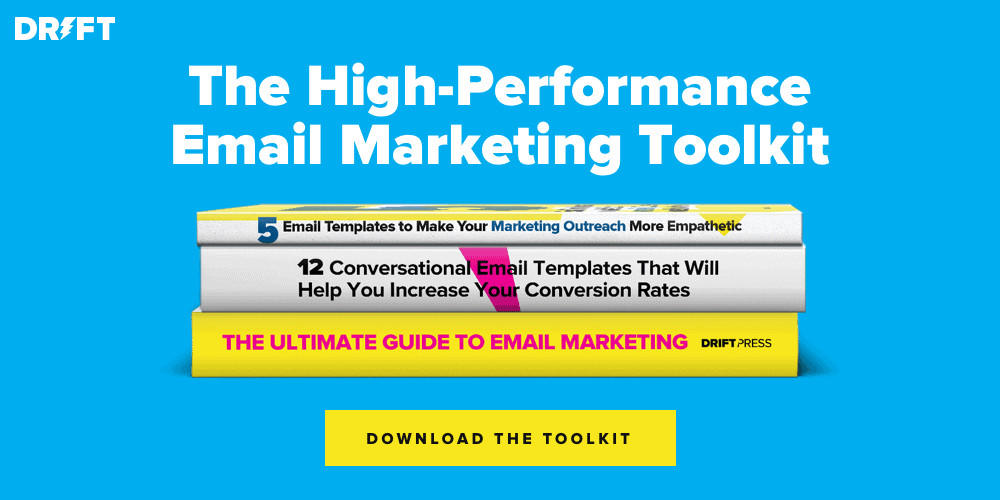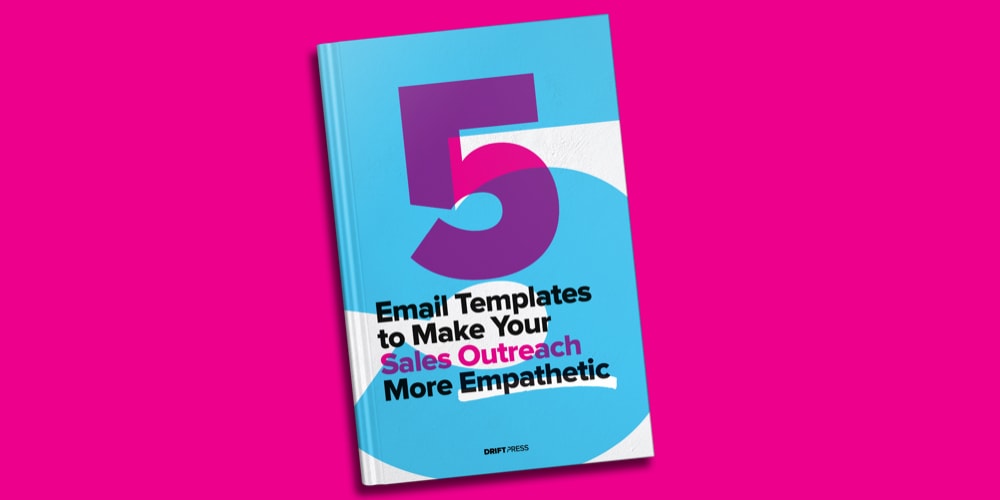
Personalization is not a new concept in email marketing. But, a personal campaign goes beyond emails filled with tokens and custom fields. It is about creating an experience framed around the person you are writing to, how you are writing, and the tone you are using.
A truly personalized email experience is one that’s conversational.
And the math adds up: 74% of marketers say targeted personalization increases customer engagement and they see a 20% increase in sales on average when using personalized experiences.
But how do you go about doing this?
You’ve got to ask the experts. And when it comes to personalized email marketing, Cynthia Price, VP of Marketing at Litmus, and Mark Kilens, VP of Content and Community at Drift, are the experts you want in your corner. In this post, I’m sharing what I learned from Cynthia and Mark – five ways to create a personalized email program that gets results.
1. Elicit a Response
When it comes to customers and buyers, you have very little time to make an impact. According to a neuromarketing study, people make subconscious decisions within .05 seconds of seeing something. That’s…not a lot of time to make an impact and stand out from the crowd.
So to make the best use of that time, your email copy needs to work for you. Good email copy is:
- Conversational and informal. But, of course, depending on the industry, you might need to button up the language.
- Short and succinct. When you are working with a timeline of milliseconds, you don’t have words to waste.
- Written how you talk. Effective email copy makes it easy for someone to respond and keeps the conversation going.
When talking about email copy, Cynthia says, “remember that this is where actual conversations happen, that this doesn’t need to feel like a website or marketing copy.”
In the example below, Scott checks in on a prospect in this conversational email – there’s no sales pitch made, just a good old-fashioned human-to-human conversation.
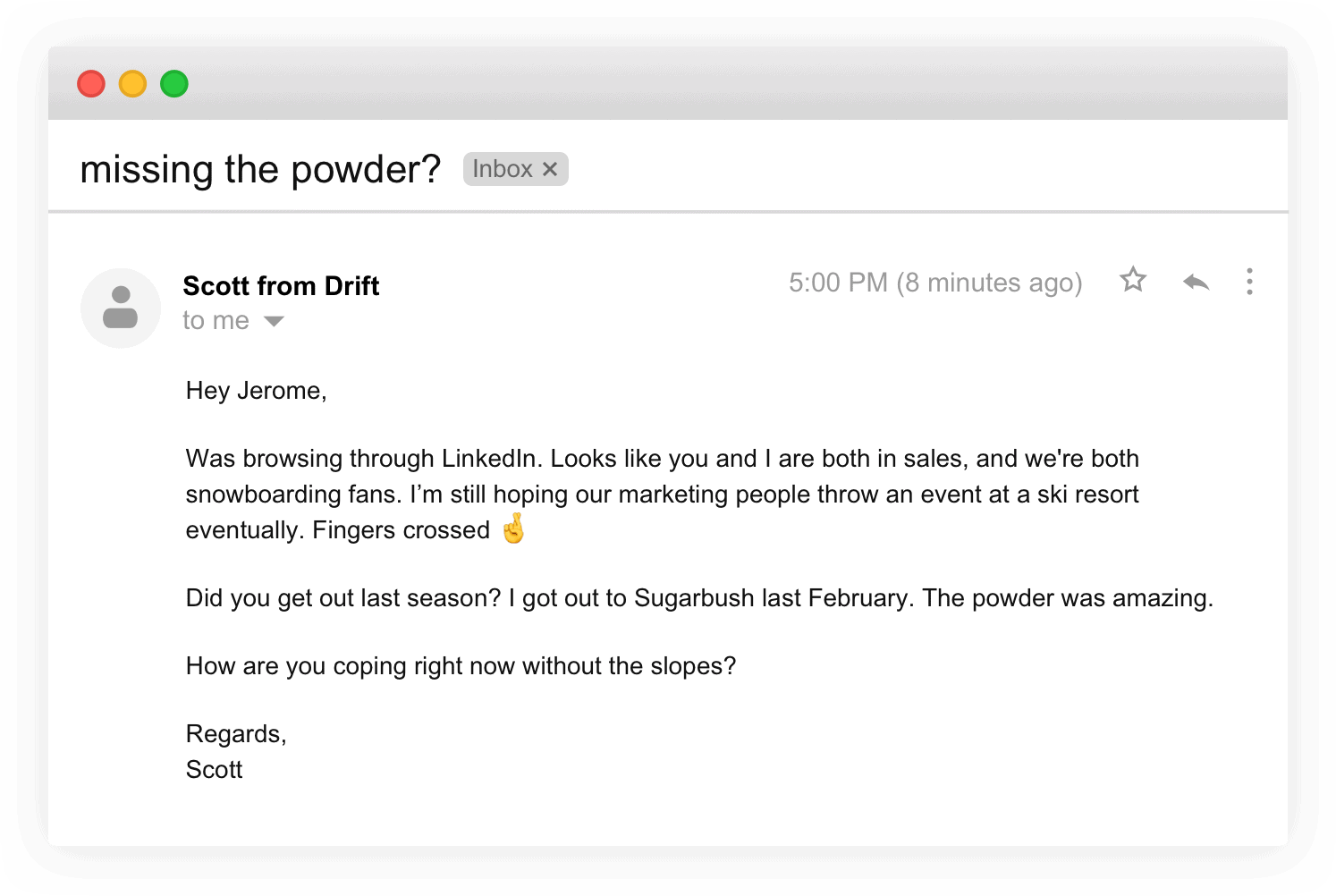
2. Keep Humans at the Center
While people spend agonizing minutes and hours crafting the perfect subject line for their email, many often overlook who the email is coming from – the sender. 69% of subscribers say they are likely to read your email because of who it’s from 👀
Here at Drift, Mark says, “we’re trying to create this instant yet personalized experience for all of these buyers and customers. And to do that we have another marketing principle…you always have to put a face to the name.” So, if you subscribe Drift emails, you might be familiar with senders like “Colleen from Drift”:
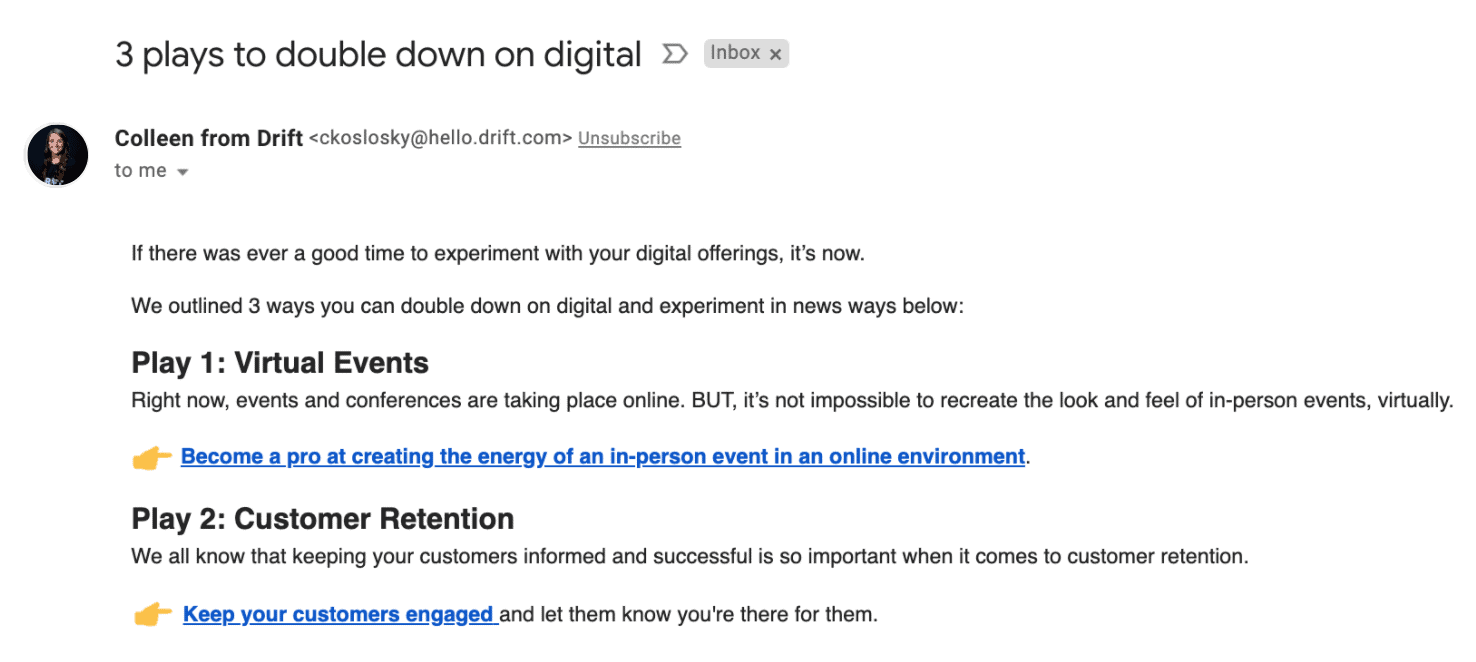
But, this might not work for all companies and brands. Even if you don’t have the option of including the human’s name in the “from” line, you need to create content as a brand that compels someone to open and respond to your emails.
A simple way to humanize an email can be to include a video or GIF to make a personal introduction.
3. Segment to the Audience
It’s impossible to craft a meaningful email or any content that resonates without first figuring out who it is that you are talking to. Once you have determine who your audience is, then you can figure out the best way to reach them.
There are a few ways to segment your audience. One is with explicit data such as demographic or firmographic information. The other is to use implicit data – using information that the customer or buyer has shared with you through their actions. This includes whether or not they attended a webinar, how they responded to a survey, what links they clicked on, and more.
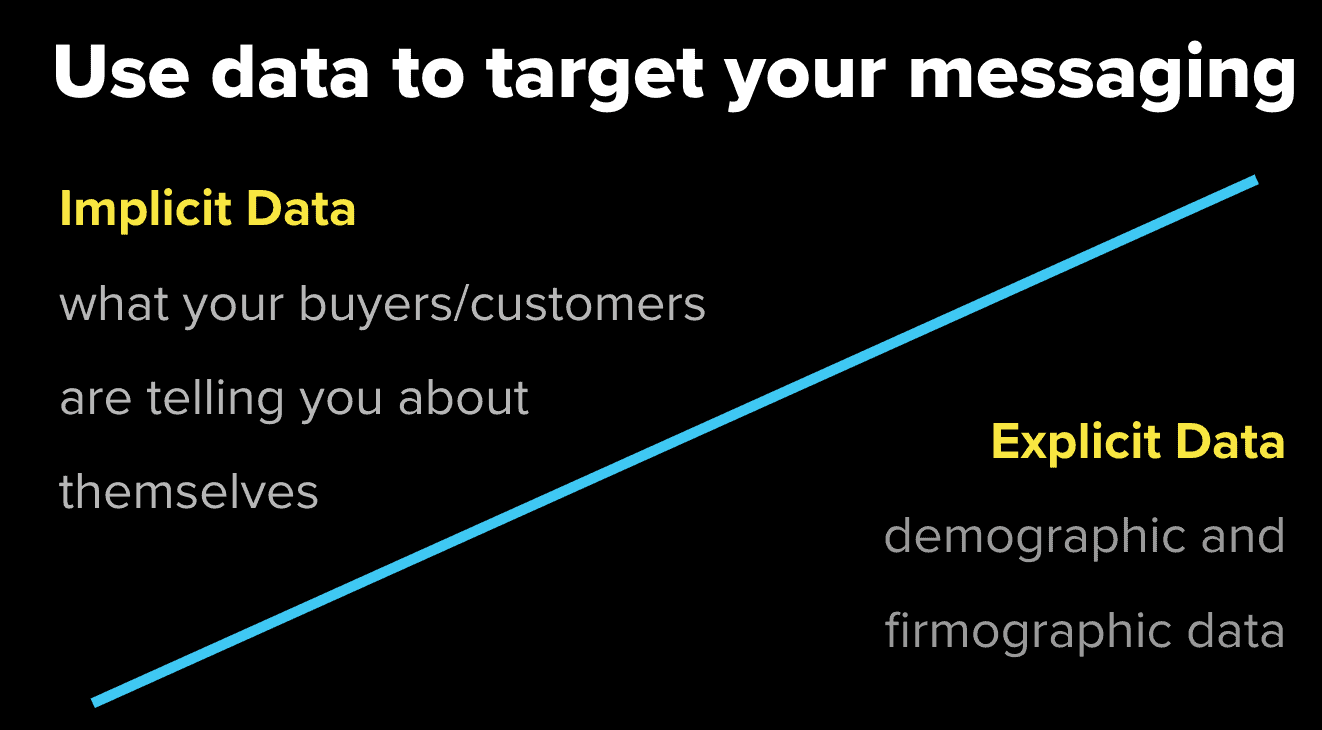
Cynthia looks to B2C businesses to find great examples of how to leverage this implicit data. Abandoned cart emails are used by most e-commerce companies to retarget shoppers and remind them of where they left off in their buying journeys. This is an experience that customers are familiar with and one that B2B companies can and should duplicate personalized calls-to-action perform 202% better than generic CTAs.
4. Give People What They Want (When They Want It)
This seems like a simple and straightforward suggestion, but can be challenging to execute correctly. As Mark says, “It’s the most important thing to do and it’s also sometimes the hardest thing to do because it requires you to really listen.”
While 34% of marketers say they use past interactions to personalize emails, there is still plenty of room to use those 5 milliseconds to really capture someone’s attention. You need to acknowledge when a potential customer raises their hand and expresses intent to buy. And you need to make it easy for them to take the next step.
According to Mark, it’s about accelerating revenue by removing friction from the customer experience. Once someone engages with one piece of content, they should seamlessly be served the next piece and moved down the funnel.
Webinar promotions are a common use-case for email marketing that can often add unnecessary friction. Most often, buyers or customers receive a series of emails inviting them to register for the webinar. One of them catches their attention and they decide to click on the CTA. And, usually, this takes them to a form where they are required to provide their email…again.
Instead, consider using tools that automate the process by eliminating instead of adding steps. The more steps it takes to get to the next stage, the more chances there are to lose out on your potential buyer.
In this example, Caitlin is able to register for a webinar by simply responding “yes” to an email invitation.
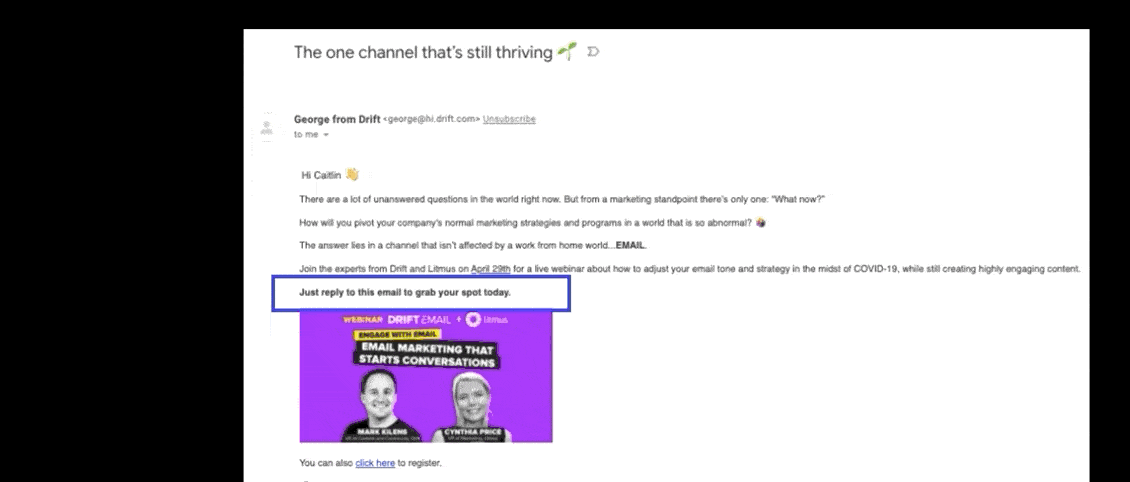
That’s what it looks like to give people what they want, when they want it ✅
5. Add Value Every Time
The opposite of asking for the same piece of information over and over again is to ask for something new with every interaction so you can get to know your buyer better. Already have their email? Ask them for their company name. Already know their company? Ask for their title. This means that you, as the marketer, need to know what information you want next and use it to enrich buyer profiles.
Using the information you have gathered can help you to create more personalized and relevant content that resonates with your target audience. Using dynamic content in emails is a great way to scale personalization and allows you to send the campaign to multiple segments while customizing the experience within it.
And it works.
Email marketing campaigns with dynamic content have a 40:1 ROI compared to 36:1 for ones that don’t.
Zapier, for example, uses dynamic content to both reinforce the user’s product usage and ask for an upsell. They retain the same messaging across multiple users and customize the performance metrics to deliver a personalized experience.

When personalization is done correctly, it does more than address a recipient by name – it also improves the performance of an email marketing campaign. Email marketing has moved beyond simple customization tokens. Successful campaigns eliminate friction, add interactive and dynamic content, and – most importantly – listen to the audience.




